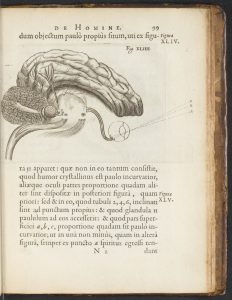De Homine


Rene Descartes (1596-1650) is primarily noted for his philosophical contemplations and the theory of mind-body dualism. In order to prove this theory, Descartes undertook many anatomical dissections to identify the mechanical means by which the human soul controlled its body. He finally landed on the pineal gland, which appeared to him to dangle in front of the brain’s ventricular cavities. Descartes believed the pineal gland to be small enough to be controlled by the soul, yet powerful enough for conscious control of the body. Descartes illustrated the pineal gland as a flap, emphasizing his idea of its anatomical role.
However, despite the excellence and detail of his illustration, Descartes’s anatomical theories were quickly discredited by trained anatomists like Thomas Bartholin and Nicholas Steno. Bartholin and Steno–more interested in empricism than armchair speculation–found no anatomical evidence to support these theories. They also considered the pineal gland’s small size to be a mark against this theory, as its mass was too small to have any direct command over the rest of the brain.
